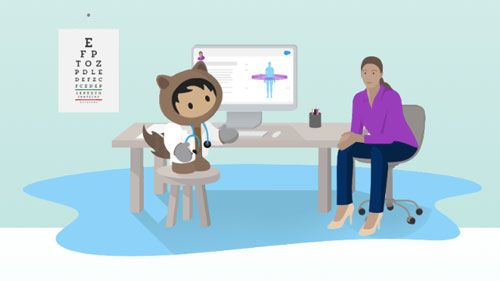We believe that a great care experience leads to increased trust, and that trust is the foundation from which healthcare practitioners can better engage patients. After all, research indicates that an engaged patient achieves better health outcomes. So, how does a company like Salesforce (better known for CRM software) unlock great healthcare experiences?
For years, we’ve supported healthcare and life sciences companies with our platform. However, in 2014, we began to develop Health Cloud, a solution purpose-built for healthcare and life sciences. A large part of our mission with Health Cloud (and our acquisition of MuleSoft) involves helping the healthcare industry to overcome the challenge of interoperability.
Interoperability has been the Achilles heel of healthcare as electronic health record (EHR) adoption has grown over the last decade. Interoperability is the process of getting computerized systems and software applications to connect, exchange, and interpret data with unambiguous, shared meaning, ideally, automating key clinical workflows — within and across organizational boundaries. While the majority of U.S. hospitals and office-based physicians have implemented an EHR system, most of these systems are developed and maintained by various incompatible vendors. This incompatibility forces healthcare professionals to toggle from one screen to another to piece together a complete view of the patient, requiring healthcare organizations to expend efforts to share data with the patients’ overall care team, often practitioners outside the organization.
An engagement layer breaks down data silos
Health Cloud layers on top of and extends the value of the EHR (and other systems). This creates an engagement layer that equips healthcare professionals with the tools to digitally engage providers and patients for personalized experiences that foster trust and loyalty. An engagement layer also brings health data together on one screen for healthcare professionals and, in turn, accelerates the path toward improved health outcomes and the safe coordination of care.
Building this engagement layer requires change, a change in thinking about the role of an EHR. Still, not all use cases are satisfied with the EHR alone. We recognize that if we are to fit into the health IT ecosystem and with EHRs, specifically, we must:
- Collaborate closely with customers and industry partners to identify, then engineer relevant use cases.
- Advocate for open APIs, orchestration services, and standards-based exchange.
- Promote a culture that views HIPAA as an enabler of innovation.
- Acknowledge and champion the power of an open, collaborative ecosystem.
Extend the value of an EHR
Designed well, an engagement layer can extend the value of EHR systems, as well as practice management and revenue-cycle management systems, with capabilities that ease complicated workflows and power relationships. Done right, we may even help doctors like their computers again. In the words of Dr. Gawande, from his New Yorker article, “Why Doctors Hate Their Computers,” “We ultimately need systems that make the right care simpler for both patients and professionals, not more complicated. And they must do so in ways that strengthen our human connections, instead of weakening them.”
When I reflect on our efforts to enable healthcare with this engagement layer, I envision a more convenient, quality, friction-free, efficient, and effective health care system for patients and providers. And, we are starting to see it — at organizations like NYU Langone, Piedmont Healthcare, and Henry Ford Healthcare System. They all use an engagement layer in response to an array of pressures — from increased competition to managing costs to scaling services — and are working through one of the leading barriers to adoption, interoperability.
Path toward interoperability — APIs, orchestration, standards
The path toward interoperability includes the use of open APIs, orchestration services, and standards-based exchange.
- Open APIs: Since 2000, we’ve promoted API-enabled fields and the foundational use of standards-based APIs (e.g., REST, Bulk, OData) in support of strategies to differentiate services. Further, as we delve more deeply into the realm of the API, we advocate for the use of enterprise-scale API management capabilities that arm organizations with what is needed to secure their endpoints.
- Orchestration services: We promote an API-led approach to connectivity where we move away from point-to-point integrations toward enterprise reusability that enable application networks and the unification of data from different systems in support of purpose-built applications that are owned and managed by the business — pushing value, and control, closer to the end user. Adopting API-led connectivity and application network approaches are necessary for our future state.
- Standards-based exchange: Open APIs and orchestration should be bolstered by a strong capability to support HL7 v2, the prevailing format for healthcare data exchange, and Fast Healthcare Interoperability Resources (FHIR), the emerging format for healthcare data exchange. Our engineering organization has previously supported the maturation of standards in other fields and we believe the latest version of the FHIR open standard for electronically exchanging healthcare information provides an essential and appropriate target for ongoing investments in interoperability. Maturing FHIR capability while broadening data models to cover the U.S. Core Data for Interoperability (USCDI) standard will enable interoperability efforts with EHRs.
We see value-based care, the 21st Century Cures Act, and the Trusted Exchange Framework and Common Agreement (TEFCA) as drivers and enablers of interoperability. However, these initiatives will take time to root. And while they have value and potential, and we recommend aligning trajectories, we should continue to move forward, without waiting for these initiatives to mature.
HIPAA as an enabler of innovation
HIPAA has power as an enabler of innovation and must guard against stakeholders unintentionally using its compliance in ways that prevent the use of innovative, new technologies in healthcare. It is an enabler insofar as it provides the foundation for ensuring the security and privacy of patients’ health information. Thus, complying with HIPAA communicates a degree of trust and a framework for accountability enabling organizations to more confidently work with their vendors. Further, it implies a partnership — between vendor and customer.
However, we need to limit misconceptions about HIPAA requirements to encourage sharing of health information among stakeholders, enabling healthcare with modern, secure systems of engagement. This culture shift is critical to embrace the power of cloud-based, mobile-friendly platforms intended to promote the safe delivery of care and the secure exchange of patient data.
An open, collaborative ecosystem
An open, collaborative ecosystem is achievable. Partnerships can be forged and data can be shared in a secure manner that prioritizes the trust of the sending entity and — most importantly — the patient and adheres to HIPAA’s confidentiality, integrity, and availability provisions. Finally, we recognize that this great experience cannot happen among providers alone. Payers and life sciences companies play an important role in the lives of patients. As such, we promote the broadest view of interoperability but intend to deliver on our commitment to better fit with EHRs now.
Learn how to engage patients, customers, and partners, download our guide, 360 Degrees of Healthcare.




























